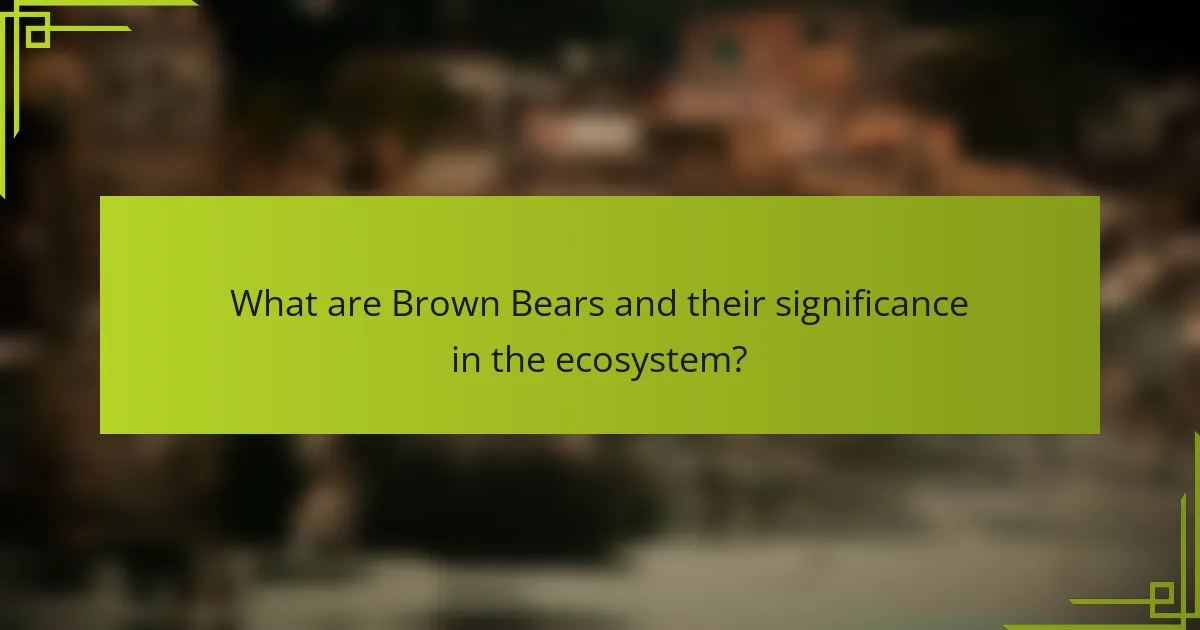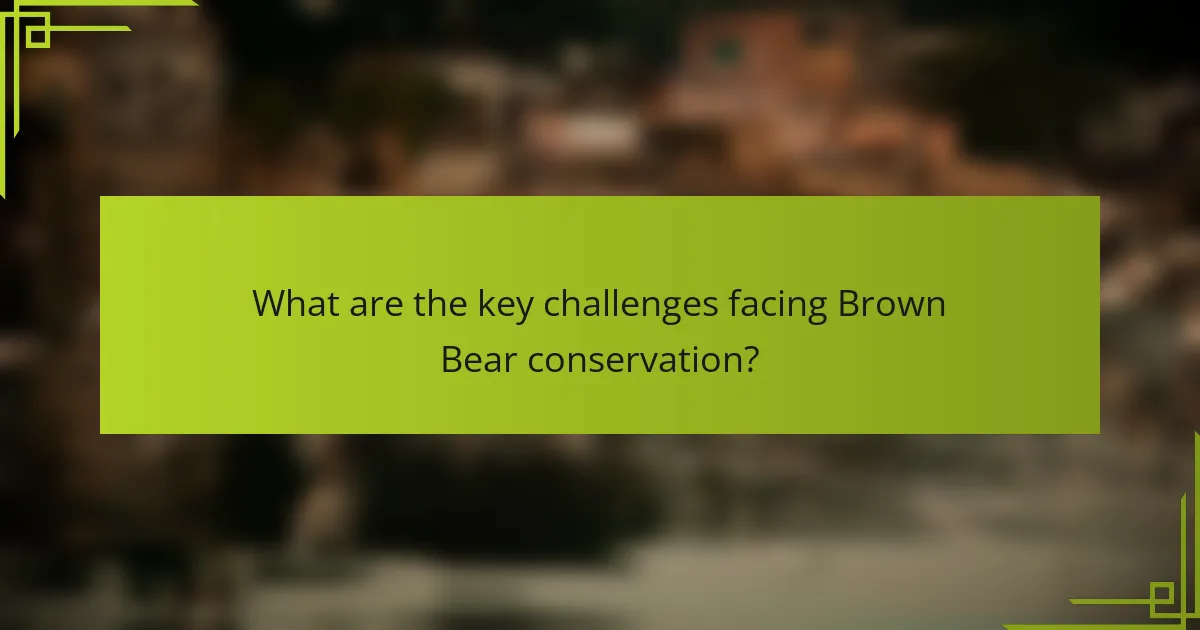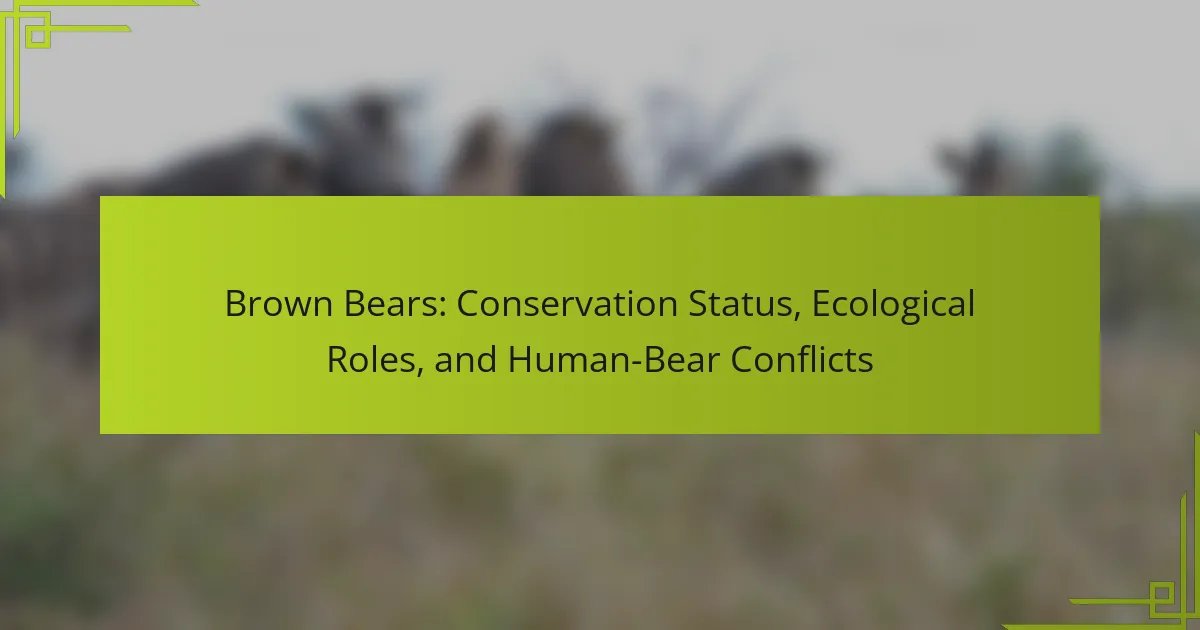Brown bears, scientifically known as Ursus arctos, are significant mammals that serve as apex predators and scavengers within their ecosystems. Their foraging activities are vital for controlling prey populations and promoting biodiversity, while also contributing to nutrient cycling and forest regeneration through seed dispersal. However, brown bears face numerous conservation challenges, including habitat loss, human-wildlife conflict, climate change, and poaching, which threaten their populations and ecological roles. Effective conservation strategies involve habitat protection, community education, and sustainable practices to mitigate human-bear conflicts and support the health of these essential species. Understanding the importance of brown bears is crucial for maintaining ecological balance and ensuring their survival.

What are Brown Bears and their significance in the ecosystem?
Brown bears are large mammals belonging to the species Ursus arctos. They play a crucial role in their ecosystems as apex predators and scavengers. Their foraging activities help control prey populations, promoting biodiversity. Brown bears also contribute to nutrient cycling by dispersing seeds through their feces. This process aids in plant growth and forest regeneration. Additionally, their hunting and scavenging behaviors create opportunities for other species to thrive. Studies indicate that healthy brown bear populations are indicators of ecosystem health. Thus, their presence is essential for maintaining ecological balance.
How do Brown Bears adapt to their environment?
Brown bears adapt to their environment through various behavioral and physiological strategies. They exhibit seasonal hibernation to conserve energy during winter months when food is scarce. Their thick fur and fat layers provide insulation against cold temperatures. Brown bears also have a varied diet, allowing them to exploit different food sources depending on availability. They can consume plants, fruits, fish, and small mammals, which helps them thrive in diverse habitats. Additionally, they have excellent foraging skills, enabling them to locate food efficiently. Their keen sense of smell aids in detecting food from great distances. Brown bears also utilize their strength and size to defend their territory and young from predators. These adaptations ensure their survival across different ecosystems.
What are the physical characteristics of Brown Bears?
Brown bears have a robust and powerful physique. They typically weigh between 300 to 1,500 pounds. [censured] males are generally larger than females. Their height can reach up to 8 feet when standing on their hind legs. Brown bears possess a distinctive hump on their shoulders, formed by large muscles used for digging. Their fur ranges from light brown to almost black, with some variations in color. They have long claws, measuring up to 4 inches, which aid in foraging. Brown bears also have a broad head with small, rounded ears. Their eyesight is poor, but they have an excellent sense of smell, which is among the best in the animal kingdom.
How do Brown Bears behave in the wild?
Brown bears exhibit a range of behaviors in the wild. They are primarily solitary animals, except for mothers with cubs or during mating season. Brown bears are omnivorous and forage for a diverse diet, including berries, fish, and small mammals. They are known for their seasonal behavior, such as hyperphagia in late summer when they consume large quantities of food to prepare for hibernation. Brown bears communicate through vocalizations, body language, and scent markings. They establish home ranges that can vary significantly in size based on food availability. Social interactions can occur, especially around abundant food sources. Brown bears also display territoriality, particularly males during mating season. These behaviors are essential for their survival and reproduction in the wild.
What is the current conservation status of Brown Bears?
The current conservation status of Brown Bears is classified as Least Concern by the International Union for Conservation of Nature (IUCN). This classification indicates that Brown Bears are not currently facing an imminent risk of extinction. However, their populations vary significantly across different regions. In some areas, such as parts of North America and Europe, populations are stable or increasing. In contrast, other regions experience threats from habitat loss, poaching, and human-wildlife conflicts. Ongoing conservation efforts aim to monitor and protect Brown Bear populations to ensure their continued survival.
What factors contribute to the decline of Brown Bear populations?
Habitat loss is a primary factor contributing to the decline of Brown Bear populations. Urban development and logging reduce their natural habitats. This leads to fragmentation, making it difficult for bears to find food and mates. Climate change also impacts their environment, affecting food availability. Human activities, such as poaching and hunting, further threaten their numbers. According to the IUCN, habitat destruction and human interference are significant threats. Additionally, road construction increases vehicle collisions with bears. These factors collectively contribute to the decline of Brown Bear populations.
How are conservation efforts addressing these challenges?
Conservation efforts are addressing challenges faced by brown bears through habitat protection, population monitoring, and conflict mitigation strategies. Habitat protection initiatives focus on preserving critical ecosystems and creating wildlife corridors. These corridors allow safe movement between habitats, reducing human-bear interactions. Population monitoring involves tracking bear numbers and health through research and data collection. This information guides conservation strategies and management practices. Conflict mitigation strategies include public education on bear behavior and safe practices in bear territory. These efforts aim to reduce negative encounters between bears and humans. Research indicates that such strategies have led to a decrease in bear-related incidents in several regions.
What ecological roles do Brown Bears play?
Brown bears play significant ecological roles as apex predators and keystone species. As apex predators, they help regulate prey populations, maintaining balance in their ecosystems. This predation prevents overgrazing and promotes healthy vegetation. Brown bears also contribute to nutrient cycling. They consume large amounts of salmon during spawning seasons and transport nutrients from aquatic to terrestrial ecosystems through their waste. This enriches the soil and supports plant growth. Furthermore, their foraging activities create habitats for other species. By digging for roots and insects, they aerate the soil and create openings for new plant growth. Overall, brown bears are vital for maintaining biodiversity and ecosystem health.
How do Brown Bears impact their habitat?
Brown bears significantly impact their habitat through their foraging and feeding behaviors. They help maintain plant diversity by dispersing seeds through their feces. This process aids in the growth of various plant species. Brown bears also create nutrient-rich areas by digging for roots and tubers. These actions benefit other wildlife and plant communities. Additionally, their predation on smaller mammals helps regulate those populations. Their presence can influence the distribution of other species in the ecosystem. Studies show that brown bears contribute to nutrient cycling in forest ecosystems. This enhances overall biodiversity and ecosystem health.
What is the significance of Brown Bears in food webs?
Brown bears play a critical role in food webs as apex predators and scavengers. Their predation helps regulate populations of herbivores and smaller carnivores. This regulation maintains the balance of the ecosystem. Brown bears also contribute to nutrient cycling. They transport nutrients from marine environments to terrestrial ecosystems through their feeding habits. For example, when they consume salmon, they deposit nutrients in the forest through their waste. This nutrient transfer supports plant growth and benefits various organisms. Studies indicate that areas with healthy brown bear populations exhibit greater biodiversity. Their presence enhances the overall health of the ecosystems they inhabit.
How do human activities affect Brown Bears?
Human activities significantly impact Brown Bears. Habitat destruction from urban development reduces their living space. This leads to increased human-bear conflicts as bears search for food. Pollution from industrial activities contaminates their environment. Overhunting and poaching decrease their population numbers. Climate change, driven by human actions, alters their food sources and hibernation patterns. Research shows that these factors contribute to the decline of Brown Bear populations in various regions. For example, studies indicate that habitat fragmentation can lead to genetic isolation in bear populations.
What are the main causes of human-bear conflicts?
The main causes of human-bear conflicts include habitat encroachment, food availability, and bear behavior. Habitat encroachment occurs when human development reduces the natural space for bears. This leads bears to venture closer to human settlements. Food availability is a significant factor; bears are attracted to human food sources like garbage and bird feeders. Improper waste management increases the likelihood of bears seeking food near homes. Bear behavior, particularly in spring and fall, can heighten conflicts as bears search for food after hibernation and before winter. Studies show that areas with abundant human food sources experience more frequent bear encounters. These factors collectively contribute to the rising incidents of human-bear conflicts.
How can communities mitigate these conflicts?
Communities can mitigate conflicts with brown bears through education and proactive management strategies. Educating residents about bear behavior reduces fear and promotes coexistence. Implementing bear-proof trash containers decreases food availability, which in turn reduces bear visits. Creating designated wildlife corridors allows bears to move safely without human interaction. Engaging in community-based monitoring programs helps track bear populations and movements. Establishing clear guidelines for human-bear interactions can prevent dangerous encounters. Research shows that communities employing these strategies experience fewer conflicts, leading to improved safety and conservation outcomes.

What are the key challenges facing Brown Bear conservation?
Key challenges facing Brown Bear conservation include habitat loss, human-wildlife conflict, and climate change. Habitat loss occurs due to urban development, logging, and agriculture, reducing the space available for bears. Human-wildlife conflict arises when bears venture into populated areas in search of food, leading to negative interactions. Climate change impacts bear habitats and food sources, disrupting their natural behaviors. Additionally, poaching and illegal hunting threaten bear populations in some regions. These challenges collectively hinder effective conservation efforts for Brown Bears.
How does habitat loss affect Brown Bear populations?
Habitat loss significantly decreases Brown Bear populations. It reduces their living space and access to food sources. As forests and wetlands are destroyed, bears face increased competition for resources. Fragmented habitats lead to isolation of bear populations. This isolation can result in reduced genetic diversity. Lower genetic diversity can make populations more vulnerable to diseases. Additionally, habitat loss increases human-bear conflicts as bears search for food in populated areas. Studies show that habitat degradation correlates with declining bear numbers in several regions.
What are the consequences of urban development on Brown Bears?
Urban development negatively impacts Brown Bears by reducing their habitat and food sources. As cities expand, natural landscapes are fragmented. This fragmentation limits bear movement and access to essential resources. Increased human activity leads to more bear-human conflicts. Bears may venture into urban areas searching for food, increasing the risk of dangerous encounters. Urban development also contributes to pollution, which can harm bear health. Research shows that habitat loss can decrease bear populations significantly. For example, studies indicate that in areas with high urbanization, bear sightings drop by over 50%.
How do climate change impacts threaten Brown Bear habitats?
Climate change impacts threaten Brown Bear habitats primarily through habitat loss and food scarcity. Rising temperatures alter the ecosystems that support these bears. Melting glaciers and reduced snowpack affect the availability of water sources. Changes in vegetation patterns disrupt the food supply, including berries and salmon. Increased wildfires destroy critical habitats, further endangering bear populations. Additionally, climate change leads to increased human-bear conflicts as bears search for food in urban areas. Studies show that these factors contribute to declining bear populations in various regions.
What role do policies play in Brown Bear conservation?
Policies play a critical role in Brown Bear conservation by establishing legal frameworks for their protection. These policies regulate hunting, habitat preservation, and human interactions with bears. For instance, the Endangered Species Act in the United States provides legal protection to threatened bear populations. This act restricts activities that could harm their habitats. Additionally, conservation policies promote research and monitoring of bear populations. Effective policies also facilitate public education on coexistence strategies. According to the International Union for Conservation of Nature, strong policy frameworks lead to improved bear population stability. Thus, well-implemented policies are essential for the long-term survival of Brown Bears.
What legislation is in place to protect Brown Bears?
The primary legislation protecting Brown Bears includes the Endangered Species Act (ESA) in the United States. This act provides legal protection to species at risk of extinction, including certain populations of Brown Bears. In addition, the Marine Mammal Protection Act safeguards the coastal populations of Brown Bears. The International Union for Conservation of Nature (IUCN) also classifies Brown Bears as a species of least concern, but specific regulations vary by region. Various states have their own laws that further protect Brown Bears from hunting and habitat destruction. These laws are enforced through wildlife management agencies, which monitor bear populations and habitats.
How effective are these policies in practice?
The effectiveness of conservation policies for brown bears varies significantly in practice. Some policies have successfully reduced human-bear conflicts. For instance, the implementation of bear-proof garbage containers in urban areas has led to a 30% decrease in bear visits. Additionally, habitat protection measures have increased bear populations in certain regions. However, challenges remain due to illegal hunting and habitat fragmentation. Studies indicate that continuous monitoring and adaptive management are crucial for policy effectiveness. Overall, while some policies show positive results, ongoing efforts are necessary to address emerging threats.

What can individuals do to support Brown Bear conservation?
Individuals can support Brown Bear conservation by participating in habitat protection efforts. This includes advocating for the preservation of natural habitats where brown bears live. Supporting local conservation organizations can enhance initiatives aimed at protecting bear populations. Educating others about the importance of brown bears in ecosystems can raise awareness. Responsible wildlife tourism can also contribute positively. Avoiding products that harm bear habitats, such as those linked to deforestation, is essential. Reporting illegal poaching or hunting activities helps protect these animals. Lastly, promoting sustainable practices in communities can reduce human-bear conflicts.
How can people contribute to local conservation efforts?
People can contribute to local conservation efforts by participating in habitat restoration projects. These projects often involve planting native vegetation and removing invasive species. Engaging in community clean-up events helps reduce pollution in natural habitats. Volunteering with local conservation organizations can provide valuable support and resources. Educating others about the importance of conservation raises awareness and promotes responsible behavior. Supporting sustainable practices in local businesses encourages eco-friendly initiatives. Reporting wildlife sightings and environmental concerns to local authorities aids in monitoring and protection efforts. Overall, active community involvement is essential for effective conservation.
What are some best practices for living in bear country?
To live safely in bear country, follow several best practices. Store food securely in bear-proof containers. Keep garbage sealed and disposed of properly. Avoid leaving pet food outside. Make noise while hiking to alert bears of your presence. Travel in groups, as bears are less likely to approach larger numbers of people. Stay calm and back away slowly if you encounter a bear. Do not run, as this may trigger a chase instinct. Educate yourself about bear behavior and local guidelines. These practices help minimize human-bear conflicts and promote safety.
How can education and awareness promote Brown Bear conservation?
Education and awareness can significantly promote Brown Bear conservation by informing the public about their ecological importance. Increased knowledge leads to greater public support for conservation initiatives. Awareness campaigns can highlight the threats faced by Brown Bears, such as habitat loss and climate change. Educational programs can foster a sense of responsibility among communities to protect these animals. Research indicates that communities engaged in conservation education are more likely to participate in protective measures. For example, studies show that educational outreach can reduce human-bear conflicts by teaching people how to coexist safely. Overall, informed individuals are more likely to advocate for policies that benefit Brown Bear conservation.
Brown bears (Ursus arctos) are significant apex predators and scavengers that play crucial roles in maintaining ecological balance and promoting biodiversity. This article explores their conservation status, highlighting challenges such as habitat loss, climate change, and human-wildlife conflicts. It details their adaptations, physical characteristics, and the ecological roles they fulfill, including nutrient cycling and seed dispersal. Additionally, the article discusses the impact of human activities on brown bear populations and outlines effective conservation strategies and community involvement methods to mitigate conflicts and support their preservation.
